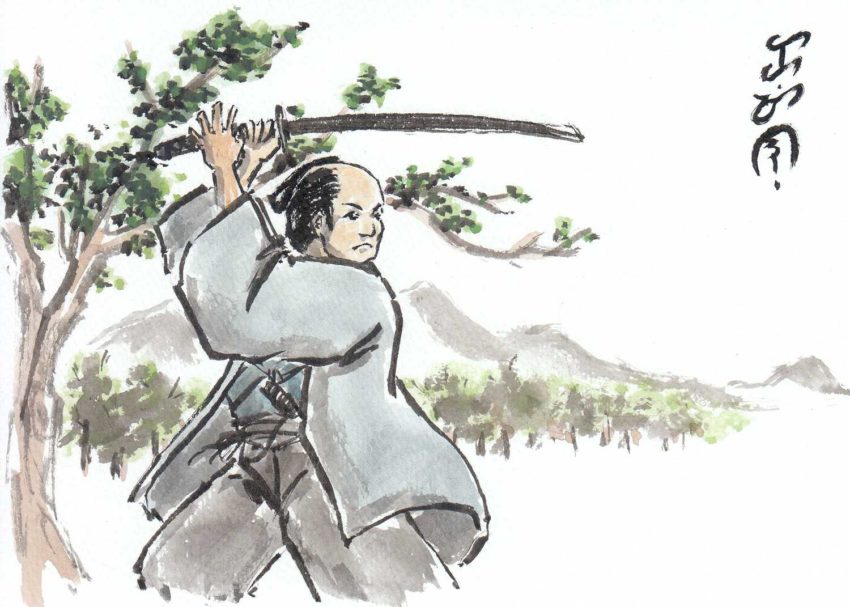The Japanese katanaKATANA 刀 "sword" learn more... is a sword of legendary quality. For centuries, master Japanese craftsmen have used remarkable techniques to forge these extraordinary blades. The legendary Japanese katana swords have enthralled people around the world for centuries. Let’s take a deeper look into what makes them so special.
Righting The Record
Firstly, let’s clear up a little misconception. A katana is a sword. Its name is sometimes said to mean “cutting-side up,” referring to the way that samurai wielded katanas in contrast to other kinds of swords. Katakana, meanwhile, is one of three widely-used Japanese writing systems. While katakana and katana have similar names, they are completely different things. There is no “Japanese katakana sword”, but there are Japanese katana swords!
Secondly, it’s not really clear if the “Japanese katana” is entirely Japanese. Some believe that the modern katana is a modified form of Chinese jian and dao swords, which were introduced to Japan many centuries before the katana. While these swords differed substantially from modern katana, it is thought that Japanese smiths learned their art by crafting swords based on these Chinese models.
Ultimately, however, the qualities that make a katana Japanese are indeed distinct in their origin.
Japanese Katana Use And Construction
Katana swords were versatile weapons, and could be wielded with either one or two hands. This flexibility led to a number of different sword styles being developed. The word kenjutsuKENJUTSU 剣術 "the art of swords" learn more... is used for these styles. Among the most influential was the quick and lethal iaijutsuIAIJUTSU 居合術 "the art of drawing a katana" learn more..., an entire martial art dedicated to the action of drawing the sword. With the introduction of iaijutsu, battles were often decided by a single stroke of the blade. As if feudal Japan wasn’t scary enough!
Samurai traditionally wielded katana as part of a set of blades called a daishoDAISHO 大小 "big and small" learn more.... A daisho set typically included both a katana and a smaller sword called a wakizashiWAKIZASHI 脇差 or 脇指 "medium-length sword" learn more.... A samurai’s daisho was important to him. The two blades were, of course, invaluable tools on the battlefield, but they also represented a samurai’s honor. It was considered deeply dishonorable for a samurai to lose any part of his daisho.
The katana, besides being a deadly weapon, was also a marvel of metalworking. To forge a katana could take anywhere from days to months of concentrated labor, usually performed by several specialists working in tandem. One person worked on the handle, another person worked on the pommel, another on the handguard, and finally, a master craftsman worked on the blade.
The forging of the blade itself was the most labor-intensive process. To create katana, smiths first refined the metal they were working on with into purest steel, called haganeHAGANE 鋼 "steel" learn more..., or “blade metal.” Once the hagane was produced, the steel ingots were hammered into thin sheets and folded on top of each other, creating thousands of minutely thin layers. These layers were then melted down until they fused together into a single piece. Once this process was completed, it was repeated, sometimes up to six times! The resulting product was both effortlessly light and stiffly durable, a testament to the work put into them.
The First Katana
The first swords that could be considered katana originated in Japan some thirteen-hundred years ago, during the 8th century, though the word “katana” wasn’t used to describe them until the 12th century. These swords, believed to be among the finest in production at the time, were designed for one very important reason: the Mongols. It is thought that early katanas were created to repel these fearsome invaders, whose thick leather armor was nearly impossibly for existing swords to penetrate.
Hence, the Japanese katana sword was birthed – “born in fire,” is the expression commonly used. The straight blades of imported Chinese designs gave way to soriSORI 反り "curve" learn more..., the familiar curvature of Japanese katana sword. Sori allowed a wielder to draw the katana stunningly quickly, making it a slashing weapon of unparalleled speed and grace.
The new katana swords, combined with a storm so fortuitous that it was called kamikazeKAMIKAZE 神風 "divine wind" learn more..., or “divine wind,” allowed the Japanese to successfully repel the Mongol invaders.
Masters of the Muromachi
The art of forging katana swords reached its height during the Muromachi period of the 14th century. Many of the most famous swordsmiths in all of Japanese history arose during this time. Bizen Province (part of modern-day Okayama) produced smiths like Osafune Morimitsu and Osafune Yasumitsu. Meanwhile, in Soshu Province (now part of Kanagawa), Masamune and Sadamune created some of the highest quality swords ever produced. Masamune’s skill was so legendary that the Masamune Prize, one of the most prestigious awards for swordsmiths in Japan, was created in his honor. Swords made in Yamashiro, Yamato, and Mino (now Kyoto, Nara, and Gifu, respectively) were also highly sought after. Blades from these provinces were so famous that they were collectively known as gokadenGOKADEN 五箇伝 五ヶ伝 "the five traditions" learn more..., “swords of the five provinces.”
The Warring States
It was not destined to last. The art of katana swordsmithing dropped off slightly during the Sengoku (warring states) period for one simple reason: people needed more swords. As a result, production became more industrialized. Less focus was put on craftsmanship and more was put on the quantity of swords produced. Lesser, mass-produced swords were so prevalent that they even had their own name: kazuuchimonoKAZUUCHIMONO 数打物 "mass-produced things" learn more..., “mass products.”
Nevertheless, several masters did emerge from the period, including Magoroku Kanemoto and Izuminokami Kanesada. Furthermore, katana swords still retained their symbolic significance. When Hideyoshi Toyotomi cemented his alliance with Tokugawa Ieyasu, his erstwhile rival, he presented Tokugawa with one of the finest swords in his collection as a peace offering, thus cementing his control over all of Japan.
The Extravagant Edo
Once Japan was united, it entered what was called the Edo or Tokugawa period, named for the capital city (now Tokyo) and shogunSHOGUN 将軍 "medieval military commander" learn more... respectively. During the Edo period, a time of relative peace, katana craftsmanship boomed. With the demand for mass-produced katana swords decreasing, the demand for more artful products prevailed. Swords of the Edo period were not necessarily designed for war, however, but were viewed increasingly as art objects. The best swords of the time were meant to be shown off, not used in battle.
Osaka was the center of Edo-period swordsmithing, producing masters such as Kunihiro Horikawa and Sukehiro Tsuda. Osaka-made swords were called Osaka Shinto, “New Osaka Swords.” Osaka Shinto were known for their ostentatious, even gaudy style of decoration, and as a result, many more seasoned samurai avoided them. Still, pieces from the Edo period are still widely admired for their beauty and elegance.
The Meiji Restoration and Beyond
During the Meiji period, an American called Commodore Matthew Perry, using a fleet of gunboats still referred to in Japan ominously as kurofuneKUROFUNE 黒船 "black ships" learn more... (“black ships”), opened Japan up to western trade. This resulted in a period of rapid industrialization. During this push for westernization, samurai culture, including the construction of katana swords, greatly diminished. In fact, in 1876, the Sword Abolishment Edict was passed, banning samurai from wielding katana swords in public altogether. This would have been bizarre and unthinkable just a short time before.
As a result of these regulations, the advancements in firearms, and the production of guntoGUNTO 軍刀 "(modern) saber" learn more... (mass-produced swords made from stainless steel), swordsmithing as an art declined in Japan throughout the late nineteenth century. (Thanks a lot, Commodore Perry.)
This trend continued well into the 20th century, and even the creation of Japanese katana swords was outlawed for a short time after World War II. While the ban has since been lifted, craftsmen trained in the old art remain rare and must go through extensive training before being allowed to produce swords. Still, it seems there is enough interest in katana to keep a spark on the forge, at least for the foreseeable future.
Katana Today
Today, katana are viewed as valuable historical and artistic pieces. Katana swords forged by famous smiths are scattered across museums and historical collections throughout the world. Some famous examples include the Mikazuki Munechika, one of the “five swords under heaven,” and the Fukuoka Ichimonji Sukezane, which are both on display at the Tokyo National Museum. Like the daimyoDAIMYO 大名 "feudal lord" learn more... of old, people come from across the world to admire these masterwork swords of the Japanese archipelago.
If you are looking into buying your own katana sword, there are a number of options available to you. There are places both in Japan and abroad that produce high quality swords, whether your interest is in an ornamental “wall-hanger,” a “beater” sword designed for durability, or an authentic blade with the hamonHAMON 刃文 "blade pattern" learn more... line that denotes a katana sword constructed in the traditional fashion. If you’re willing to spend the money, an antique sword would also be an excellent addition to any collection.
Japanese katana are fascinating and beautiful swords that come from a centuries-old tradition of excellence. The level of craftsmanship that goes into them, and their deadly effective use on the battlefield, stoke the imaginations of historians and laymen alike. It is no wonder that people all over the world are fascinated by these Japanese swords and the legacy of blood and steel they have left behind.

